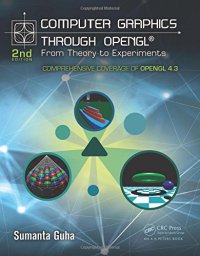
Ebook: Computer Graphics Through OpenGL: From Theory to Experiments, Second Edition
Author: Sumanta Guha
- Tags: Graphics Design Adobe CAD Computer Modelling Desktop Publishing Electronic Documents Rendering Ray Tracing User Experience Usability Computers Technology OpenGL Multimedia Programming Mathematics Applied Geometry Topology History Infinity Mathematical Analysis Matrices Number Systems Popular Elementary Pure Reference Research Study Teaching Transformations Trigonometry Science Math Visualization New Used Rental Textbooks Specialty Boutique Algebra Calculus Statistics
- Year: 2014
- Publisher: A K Peters/CRC Press
- Edition: 2
- Language: English
- pdf
From geometric primitives to animation to 3D modeling to lighting, shading, and texturing, Computer Graphics Through OpenGL®: From Theory to Experiments, Second Edition presents a comprehensive introduction to computer graphics that uses an active learning style to teach key concepts. Equally emphasizing theory and practice, the book provides an understanding not only of the principles of 3D computer graphics, but also the use of the OpenGL® Application Programming Interface (API) to code 3D scenes and animation, including games and movies.
The undergraduate core of the book is a one-semester sequence taking the student from zero knowledge of computer graphics to a mastery of the fundamental concepts with the ability to code applications using fourth-generation OpenGL. The remaining chapters explore more advanced topics, including the structure of curves and surfaces and the application of projective spaces and transformations.
New to the Second Edition
- 30 more programs, 50 more experiments, and 50 more exercises
- Two new chapters on OpenGL 4.3 shaders and the programmable pipeline
- Coverage of:
- Vertex buffer and array objects
- Occlusion culling and queries and conditional rendering
- Texture matrices
- Multitexturing and texture combining
- Multisampling
- Point sprites
- Image and pixel manipulation
- Pixel buffer objects
- Shadow mapping
Web Resource
The book’s website at www.sumantaguha.com provides program source code that runs on various platforms. It includes a guide to installing OpenGL and executing the programs, special software to help run the experiments, and figures from the book. The site also contains an instructor’s manual with solutions to 100 problems (for qualifying instructors only).